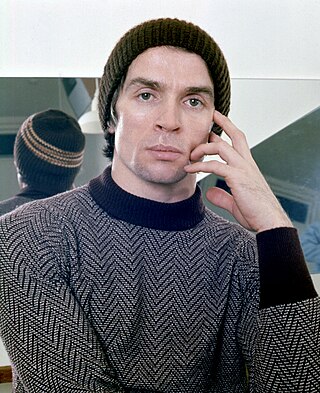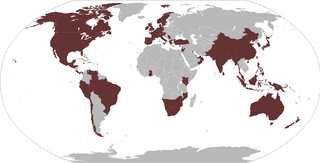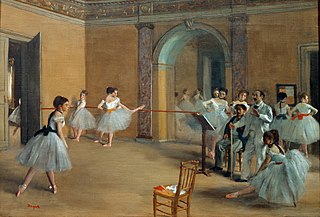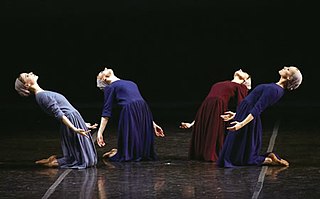
Ballet is a type of performance dance that originated during the Italian Renaissance in the fifteenth century and later developed into a concert dance form in France and Russia. It has since become a widespread and highly technical form of dance with its own vocabulary. Ballet has been influential globally and has defined the foundational techniques which are used in many other dance genres and cultures. Various schools around the world have incorporated their own cultures. As a result, ballet has evolved in distinct ways.

Rudolf Khametovich Nureyev was a Soviet-born ballet dancer and choreographer. Nureyev is regarded by some as the greatest male ballet dancer of his generation.
The Cecchetti method is variously defined as a style of ballet and as a ballet training method devised by the Italian ballet master Enrico Cecchetti (1850–1928). The training method seeks to develop essential skills in dancers as well as strength and elasticity. Cecchetti-trained dancers are commonly found in ballet and other dance companies throughout the world.

The Royal Academy of Dance (RAD) is a UK-based examination board specialising in dance education and training, with an emphasis on classical ballet. The RAD was founded in London, England in 1920 as the Association of Teachers of Operatic Dancing, and was granted a Royal Charter in 1935. Queen Elizabeth II was patron of the RAD and Darcey Bussell was elected to serve as president in 2012, succeedingPresident Antoinette Sibley who served for 21 years.

Classical ballet is any of the traditional, formal styles of ballet that exclusively employ classical ballet technique. It is known for its aesthetics and rigorous technique, its flowing, precise movements, and its ethereal qualities.

Suzanne Farrell is an American ballerina and the founder of the Suzanne Farrell Ballet at the Kennedy Center in Washington, D.C.
Houston Ballet, operated by Houston Ballet Foundation, is a professional ballet company based in Houston, Texas. The company consists of 59 dancers and produces over 85 performances per year.

The Boston Ballet is an American professional classical ballet company based in Boston, Massachusetts. It was founded in 1963 by E. Virginia Williams and Sydney Leonard, and was the first professional repertory ballet company in New England. It has been led by Violette Verdy (1980–1984), Bruce Marks (1985–1997), and Anna-Marie Holmes (1997–2000). Mikko Nissinen was appointed artistic director in September 2001.

The Pittsburgh Ballet Theatre (PBT) is an American professional ballet company based in the Strip District of Pittsburgh, Pennsylvania (USA).
The South Carolina Governor's School for the Arts & Humanities (SCGSAH) is a prestigious boarding school for the arts located in Greenville, South Carolina, United States. Founded in 1999 by Virginia Uldrick, the high school program provides pre-professional training in creative writing, dance, drama, music and visual arts to sophomores, juniors and seniors, in a master-apprentice, arts-centered community. The Governor's School also offers arts-intensive summer programs for 7th-through-12th-grade students.

Tiler Kalyn Peck is an American ballet dancer who is a principal dancer with the New York City Ballet. As well as ballet, she has performed in musical theatre shows and has made cameo appearances in films including Donnie Darko and television series including Tiny Pretty Things.

Modern dance is a broad genre of western concert or theatrical dance which included dance styles such as ballet, folk, ethnic, religious, and social dancing; and primarily arose out of Europe and the United States in the late 19th and early 20th centuries. It was considered to have been developed as a rejection of, or rebellion against, classical ballet, and also a way to express social concerns like socioeconomic and cultural factors.
British ballet is most recognised for two leading methods, those of the Royal Ballet School and the Royal Academy of Dance. The identifying characteristic of British ballet is the focus on clean, precise technique and purity of line that is free of exaggeration and mannerisms. The training of dancers in Britain is noted for its slow progression, with a great deal of attention paid to basic technique. British ballet methods operate on the principle that establishing correct technique and strength slowly makes it much easier for the student to adapt to more difficult vocabulary and techniques later on.
Sharni Spencer is an Australian ballet dancer. She is a soloist and senior artist at The Australian Ballet.
Stephanie Williams is an Australian ballet dancer, a member of the corps de ballet of the American Ballet Theatre.

The important place of women in dance can be traced back to the origins of civilization. Cave paintings, Egyptian frescos, Indian statuettes, ancient Greek and Roman art and records of court traditions in China and Japan all testify to the important role women played in ritual and religious dancing from the start. In the Middle Ages, what has become known as ballet had its beginnings in Italian court festivals when women frequently played the parts of men. It was however in late 17th-century France that the Paris Opera produced the first celebrated ballerinas. While women began to dominate the ballet scene in the 18th century, it was with the advent of Romantic ballet in the 19th century that they became the undisputed centre of attraction with stars playing the leading roles in the works of Marius Petipa, appearing in theatres across Europe from Milan's La Scala to the Mariinsky Theatre in Saint Petersburg. More recently, women have played a leading role in developing various forms of modern dance including flamenco and expressionist dance.
Jenna Roberts is a retired Australian ballet dancer, formerly a principal dancer with Birmingham Royal Ballet (BRB)

Marie Walton-Mahon is an Australian ballet dancer, ballet teacher and adjudicator. She is the founder of National College of Dance, Marie Walton-Mahon Dance Academy and the founder of the Progressing Ballet Technique.
Black women have been traditionally underrepresented in ballet. In the 15th and 16th centuries, ballet began in Italian Renaissance courts, where it was largely dominated and influenced by the aristocracy. Ballet later spread to France and was developed under Louis XIV. After the first professional theatrical ballet company, the Paris Opera Ballet, was established in 1669, ballet spread throughout Europe and the rest of the world. Ballet eventually arrived in the United States, and by 1933, the San Francisco Ballet, the first professional ballet company in the United States, was founded.










